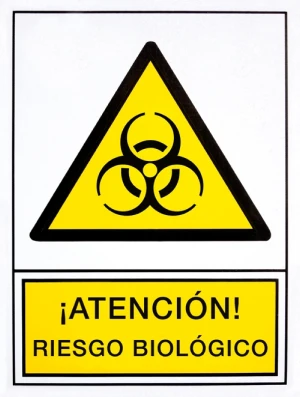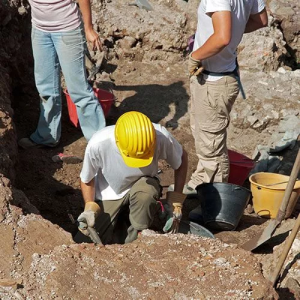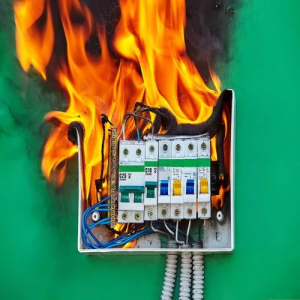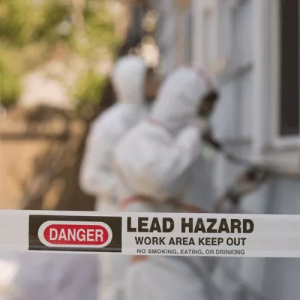Glossary Electrical Safety Training (NFPA 70E)
Success
Acceptable
Acceptable means that an installation or equipment is acceptable to the Assistant Secretary of Labor and approved within the meaning of 29 CFR 1910 Subpart S- If it is accepted, or certified, or listed, or labeled, or otherwise determined to be safe by a nationally recognized testing laboratory recognized pursuant to § 1910.7; or
- With respect to an installation or equipment of a kind that no nationally recognized testing laboratory accepts, certifies, lists, labels, or determines to be safe, if it is inspected or tested by another Federal agency, or by a State, municipal, or other local authority responsible for enforcing occupational safety provisions of the National Electrical Code and found in compliance with the provisions of the National Electrical Code as applied in this subpart; or
- With respect to custom-made equipment or related installations that are designed, fabricated for, and intended for use by a particular customer, if it is determined to be safe for its intended use by its manufacturer on the basis of test data which the employer keeps and makes available for inspection to the Assistant Secretary and his authorized representatives.
Accepted
An installation is "accepted" if it has been inspected and found by a nationally recognized testing laboratory to conform to specified plans or procedures of applicable codes.Accessible (as applied to Wiring Methods)
Accessible (as applied to wiring methods) means capable of being removed or exposed without damaging the building structure or finish, or not permanently closed in by the structure or finish of the building. (See "concealed" and "exposed.")Accessible (as applied to Equipment)
Accessible (as applied to equipment) means admitting close approach; not guarded by locked doors, elevation, or other effective means. (See "readily accessible."Affected Employee
An employee whose job requires him/her to operate or use a machine or equipment on which servicing or maintenance is being performed under lockout or tagout, or whose job requires him/her to work in an area in which such servicing or maintenance is being performed.Alternating Current
An employee whose job requires him/her to operate or use a machine or equipment on which servicing or maintenance is being performed under lockout or tagout, or whose job requires him/her to work in an area in which such servicing or maintenance is being performed.Ampacity
The current, in amperes, that a conductor can carry continuously under the conditions of use without exceeding its temperature rating.Appliances
Acceptable to the authority enforcing this subpart. The authority enforcing this subpart is the Assistant Secretary of Labor for Occupational Safety and Health. The definition of "acceptable" indicates what is acceptable to the Assistant Secretary of Labor and therefore approved within the meaning of 29 CFR 1910 Subpart S.Approved
Acceptable to the authority enforcing this subpart. The authority enforcing this subpart is the Assistant Secretary of Labor for Occupational Safety and Health. The definition of "acceptable" indicates what is acceptable to the Assistant Secretary of Labor and therefore approved within the meaning of 29 CFR 1910 Subpart S.Arc Flash Boundary
According to Article 100 of the NFPA 70E, when an arc flash hazard exists, an approach limit from an arc source at which the incident energy equals 1.2 cal/cm2 (5 J/cm2).Arc Flash PPE Category Method
There are four categories of arc flash PPE ranging from 1 through 4. Based on the arc flash risk assessment, a category is selected for personnel protection.Arcing
The luminous electrical discharge (bright, electrical sparking) through the air that occurs when high voltages exist across a gap between conductors.Arc Performance Thermal Value (APTV)
The incident energy on a material or a multi-layer system of materials that results in a 50 percent probability that heat transfer through the specimen is predicted to cause the onset of a second-degree skin burn injury based on the Stoll curve.Armored Cable (Type AC)
A fabricated assembly of insulated conductors in a flexible metallic enclosure.Askarel
A generic term for a group of non-flammable synthetic, chlorinated hydrocarbons used as electrical insulating media. Askarels of various compositional types are used. The gases produced under arcing conditions, while consisting predominantly of non-combustible hydrogen chloride, can include varying amounts of combustible gases depending upon the askarel type.Attachment Plug (Plug Cap) (Cap)
A device that, by insertion in a receptacle, establishes a connection between the conductors of the attached flexible cord and the conductors connected permanently to the receptacle.Authorized Employee
A person who locks out or tags out machines or equipment in order to perform servicing or maintenance on that machine or equipment. An affected employee becomes an authorized employee when that employee's duties include performing servicing or maintenance covered under this 29 CFR 1910 Subpart S.Automatic
Self-acting, operating by its own mechanism when actuated by some impersonal influence, as, for example, a change in current strength, pressure, temperature, or mechanical configuration.Bare Conductor
See ConductorBarrier
A physical obstruction that is intended to prevent contact with equipment or live parts or to prevent unauthorized access to a work area.Bathroom
An area including a basin with one or more of the following: a toilet, a tub, or a shower.Battery
According to Article 100 of the NFPA 70E, a battery is a system consisting of two or more electrochemical cells connected in series or parallel and capable of storing electrical energy received and that can give it back by reconversion.Battery Room
According to Article 100 of the NFPA 70E, a battery room is a room specifically intended for the installation of batteries that have no other protective enclosure.Bonding (Bonded)
The permanent joining of metallic parts to form an electrically conductive path that ensures electrical continuity and the capacity to conduct safely any current likely to be imposed.Bonding Jumper
A conductor that assures the necessary electrical conductivity between metal parts required to be electrically connected.Branch Circuit
The circuit conductors between the final overcurrent device protecting the circuit and the outlets.Building
A structure that stands alone or is cut off from adjoining structures by fire walls with all openings therein protected by approved fire doors.Cabinet
An enclosure designed either for surface or flush mounting, and provided with a frame, mat, or trim in which a swinging door or doors are or can be hungCable Bus
An assembly of insulated conductors with fittings and conductor terminations in a completely enclosed, ventilated, protective metal housing.Cell Line
An assembly of electrically interconnected electrolytic cells supplied by a source of direct current power.Cell Line Attachments and Auxiliary Equipment
Cell line attachments and auxiliary equipment include, but are not limited to, auxiliary tanks, process piping, ductwork, structural supports, exposed cell line conductors, conduits and other raceways, pumps, positioning equipment, and cell cutout or bypass electrical devices. Auxiliary equipment also includes tools, welding machines, crucibles, and other portable equipment used for operation and maintenance within the electrolytic cell line working zone. In the cell line working zone, auxiliary equipment includes the exposed conductive surfaces of ungrounded cranes and crane-mounted cell-servicing equipment.Center Pivot Irrigation Machine
A multi-motored irrigation machine that revolves around a central pivot and employs alignment switches or similar devices to control individual motors.Certified
Equipment is "certified" if it bears a label, tag, or other record of certification that the equipment:- Has been tested and found by a nationally recognized testing laboratory to meet nationally recognized standards or to be safe for use in a specified manner; or
- Is of a kind whose production is periodically inspected by a nationally recognized testing laboratory and is accepted by the laboratory as safe for its intended use.
Circuit Breaker
A device designed to open and close a circuit by non-automatic means, which can open the circuit automatically on a predetermined overcurrent without damage to itself when properly applied within its rating.Class I Locations
Class I locations are those in which flammable gases or vapors are or may be present in the air in quantities sufficient to produce explosive or ignitable mixtures. Class I locations include the following:- Class I, Division 1 - A Class I, Division 1 location is a location:
- In which ignitable concentrations of flammable gases or vapors may exist under normal operating conditions; or
- In which ignitable concentrations of such gases or vapors may exist frequently because of repair or maintenance operations or because of leakage; or
- In which breakdown or faulty operation of equipment or processes might release ignitable concentrations of flammable gases or vapors, and might also cause simultaneous failure of electric equipment.
- Class I, Division 2 - A Class I, Division 2 location is a location:
- In which volatile flammable liquids or flammable gases are handled, processed, or used, but in which the hazardous liquids, vapors, or gases will normally be confined within closed containers or closed systems from which they can escape only in the event of accidental rupture or breakdown of such containers or systems, or as a result of abnormal operation of equipment; or
- In which ignitable concentrations of gases or vapors are normally prevented by positive mechanical ventilation, and which might become hazardous through failure or abnormal operations of the ventilating equipment; or
- That is adjacent to a Class I, Division 1 location, and to which ignitable concentrations of gases or vapors might occasionally be communicated unless such communication is prevented by adequate positive-pressure ventilation from a source of clean air, and effective safeguards against ventilation failure are provided.
- Class I, Zone 0 - A Class I, Zone 0 location is a location in which one of the following conditions exists:
- Ignitable concentrations of flammable gases or vapors are present continuously; or
- Ignitable concentrations of flammable gases or vapors are present for long periods of time.
- Class I, Zone 1 - A Class I, Zone 1 location is a location in which one of the following conditions exists:
- Ignitable concentrations of flammable gases or vapors are likely to exist under normal operating conditions; or
- Ignitable concentrations of flammable gases or vapors may exist frequently because of repair or maintenance operations or because of leakage; or
- Equipment is operated or processes are carried on of such a nature that equipment breakdown or faulty operations could result in the release of ignitable concentrations of flammable gases or vapors and also cause simultaneous failure of electric equipment in a manner that would cause the electric equipment to become a source of ignition; or
- A location that is adjacent to a Class I, Zone 0 location from which ignitable concentrations of vapors could be
- Class I, Zone 2 - A Class I, Zone 2 location is a location in which one of the following conditions exists:
- Ignitable concentrations of flammable gases or vapors are not likely to occur in normal operation and if they do occur will exist only for a short period; or
- Volatile flammable liquids, flammable gases, or flammable vapors are handled, processed, or used, but in which the liquids, gases, or vapors are normally confined within closed containers or closed systems from which they can escape only as a result of accidental rupture or breakdown of the containers or system or as the result of the abnormal operation of the equipment with which the liquids or gases are handled, processed, or used; or
- Ignitable concentrations of flammable gases or vapors normally are prevented by positive mechanical ventilation, but which may become hazardous as the result of failure or abnormal operation of the ventilation equipment; or
- A location that is adjacent to a Class I, Zone 1 location, from which ignitable concentrations of flammable gases or vapors could be communicated, unless such communication is prevented by adequate positive-pressure ventilation from a source of clean air, and effective safeguards against ventilation failure are provided.
Class II Locations
Class II locations are those that are hazardous because of the presence of combustible dust. Class II locations include the following:- Class II, Division 1 - A Class II, Division 1 location is a location:
- In which combustible dust is or may be in suspension in the air under normal operating conditions, in quantities sufficient to produce explosive or ignitable mixtures; or
- Where mechanical failure or abnormal operation of machinery or equipment might cause such explosive or ignitable mixtures to be produced, and might also provide a source of ignition through simultaneous failure of electric equipment, through operation of protection devices, or from other causes; or
- In which combustible dusts of an electrically conductive nature may be present.
- Class II, Division 2 - A Class II, Division 2 location is a location where:
- Combustible dust will not normally be in suspension in the air in quantities sufficient to produce explosive or ignitable mixtures, and dust accumulations will normally be insufficient to interfere with the normal operation of electric equipment or other apparatus, but combustible dust may be in suspension in the air as a result of infrequent malfunctioning of handling or processing equipment; and
- Resulting combustible dust accumulations on, in, or in the vicinity of the electric equipment may be sufficient to interfere with the safe dissipation of heat from electric equipment or may be ignitable by abnormal operation or failure of electric equipment. Note to the definition of "Class II, Division 2:" This classification includes locations where dangerous concentrations of suspended dust would not be likely, but where dust accumulations might form on or in the vicinity of electric equipment.
Class III Locations
Class III locations are those that are hazardous because of the presence of easily ignitable fibers or flyings, but in which such fibers or flyings are not likely to be in suspension in the air in quantities sufficient to produce ignitable mixtures. Class III locations include the following:- Class III, Division 1 - A Class III, Division 1 location is a location in which easily ignitable fibers or materials producing combustible flyings are handled, manufactured, or used. Note to the definition of "Class III, Division 1:" Such locations usually include some parts of rayon, cotton, and other textile mills; combustible fiber manufacturing and processing plants; cotton gins and cotton-seed mills; flax-processing plants; clothing manufacturing plants; woodworking plants, and establishments; and industries involving similar hazardous processes or conditions. Easily ignitable fibers and flyings include rayon, cotton (including cotton linters and cotton waste), sisal or henequen, istle, jute, hemp, tow, cocoa fiber, oakum, baled waste kapok, Spanish moss, excelsior, and other materials of similar nature.
- Class III, Division 2 - A Class III, Division 2 location is a location in which easily ignitable fibers are stored or handled, other than in the process of manufacture.
- Bare means a conductor having no covering or electrical insulation whatsoever.
- Covered means a conductor encased within material of composition or thickness that is not recognized by 29 CFR 1910 Subpart S as electrical insulation.
- Insulated means a conductor encased within material of composition and thickness that is recognized by 29 CFR 1910 Subpart S as electrical insulation.
Collector Ring
An assembly of slip rings for transferring electric energy from a stationary to a rotating member.Competent Person
A person who is capable of identifying existing and predictable hazards in the surroundings, as well as working conditions that are unsanitary, hazardous, or dangerous to employees, and who has authorization to take prompt corrective measures to eliminate them.Concealed
Rendered inaccessible by the structure or finish of the building. Wires in concealed raceways are considered concealed, even though they may become accessible by withdrawing them. (See accessible (as applied to wiring methods)).Conductor
Conductor:Conduit Body
A separate portion of a conduit or tubing system that provides access through one or more removable covers to the interior of the system at a junction of two or more sections of the system or at a terminal point of the system. Boxes such as FS and FD or larger cast or sheet metal boxes are not classified as conduit bodies.Controller
Controller means a device or group of devices that serves to govern, in some predetermined manner, the electric power delivered to the apparatus to which it is connected.Covered Conductor
See conductor.Cutout (Over 600 Volts, Nominal)
An assembly of a fuse support with either a fuse holder, fuse carrier, or disconnecting blade. The fuse holder or fuse carrier may include a conducting element (fuse link), or may act as the disconnecting blade by the inclusion of a non-fusible member.Cutout Box
An enclosure designed for surface mounting, having swinging doors or covers secured directly to, and telescoping with, the walls of the box proper. (See Cabinet.)Damp Location
See location.Dead Front
Without live parts exposed to a person on the operating side of the equipmentDe-energized
Free from any electrical connection to a source of potential difference and from electrical charge; not having a potential different from that of the earth.Device
A unit of an electrical system that is intended to carry but not utilize electric energy.Dielectric Heating
The heating of a nominally insulating material due to its own dielectric losses when the material is placed in a varying electric field.Direct Current
Direct current is electricity that flows in one direction. Direct current has a steady flow that does not reverse. A battery provides direct current.Disconnecting Means
A device, or group of devices, or other means by which the conductors of a circuit can be disconnected from their source of supply.Disconnecting (or Isolating) Switch (Over 600 Volts, Nominal)
A mechanical switching device used for isolating a circuit or equipment from a source of power.Double-Insulated Tools
These tools have two insulation barriers and no exposed metal parts.Electrical Shock
An electric shock occurs when current passes through the body. The current can cause damage to muscles (including heart muscles), the nervous system, and other parts of the body.Electrolytic Cell Line Working Zone
The space envelope wherein operation or maintenance is normally performed on or in the vicinity of exposed energized surfaces of electrolytic cell lines or their attachments.Electrocution
Death by electricity.Electrolytic Cells
A tank or vat in which electrochemical reactions are caused by applying energy for the purpose of refining or producing usable materials.Enclosed
Surrounded by a case, housing, fence, or walls that will prevent persons from accidentally contacting energized parts.Enclosure
The case or housing of apparatus, or the fence or walls surrounding an installation to prevent personnel from accidentally contacting energized parts or to protect the equipment from physical damage.Energized
Electrically connected to a source of potential difference.Energy of Breakopen Threshold (EBT)
The incident energy on a material or material system that results in a 50 percent probability of breakopen. Breakopen is a material response evidenced by the formation of one or more holes of a defined size (an area of 1.6 cm2 or an opening of 2.5 cm in any dimension) in the innermost layer of the arc-rated material that would allow thermal energy to pass through the materialEquipment
A general term including material, fittings, devices, appliances, fixtures, apparatus, and the like, used as a part of, or in connection with, an electrical installation.Equipment Grounding Conductor
See grounding conductor, equipmentExplosion-Proof Apparatus
Apparatus enclosed in a case that is capable of withstanding an explosion of a specified gas or vapor that may occur within it and of preventing the ignition of a specified gas or vapor surrounding the enclosure by sparks, flashes, or explosion of the gas or vapor within, and that operates at such an external temperature that it will not ignite a surrounding flammable atmosphere.Exposed (As Applied to Live Parts)
Capable of being inadvertently touched or approached nearer than a safe distance by a person. It is applied to parts not suitably guarded, isolated, or insulated. (See accessible and concealed.)Exposed (For the Purposes of §1910.308(e))
Exposed (for the purposes of § 1910.308(e)) means where the circuit is in such a position that in case of failure of supports or insulation, contact with another circuit may result.Exposed (For the Purposes of §1910.308(e))
Exposed (for the purposes of § 1910.308(e)) means where the circuit is in such a position that in case of failure of supports or insulation, contact with another circuit may result.Externally Operable
Capable of being operated without exposing the operator to contact with live parts.Feeder
All circuit conductors between the service equipment, the source of a separate derived system, or other power supply source and the final branch-circuit overcurrent device.Fitting
An accessory such as a locknut, bushing, or other part of a wiring system that is intended primarily to perform a mechanical rather than an electrical function.Fountain
Fountains, ornamental pools, display pools, and reflection pools. Note to the definition of "fountain:" This definition does not include drinking fountains.Fuse (Over 600 Volts, Nominal)
An overcurrent protective device with a circuit opening fusible part that is heated and severed by the passage of overcurrent through it. A fuse comprises all the parts that form a unit capable of performing the prescribed functions. It may or may not be the complete device necessary to connect it into an electrical circuit.Ground
A conducting connection, whether intentional or accidental, between an electric circuit or equipment and the earth, or to some conducting body that serves in place of the earth.Grounded
Connected to the earth or to some conducting body that serves in place of the earth.Grounded, Effectively
Intentionally connected to earth through a ground connection or connections of sufficiently low impedance and having sufficient current-carrying capacity to prevent the buildup of voltages that may result in undue hazards to connected equipment or to persons.Grounded Conductor
A system or circuit conductor that is intentionally grounded.Grounding Conductor
A conductor used to connect equipment or the grounded circuit of a wiring system to a grounding electrode or electrodes.Grounding Conductor, Equipment
The conductor used to connect the non-current-carrying metal parts of equipment, raceways, and other enclosures to the system grounded conductor, the grounding electrode conductor, or both, at the service equipment or at the source of a separately derived system.Grounding Electrode Conductor
The conductor used to connect the grounding electrode to the equipment grounding conductor, to the grounded conductor, or to both, of the circuits at the service equipment or at the source of a separately derived system.Ground Fault
A loss of current from a circuit to a ground connection.Ground-Fault Circuit-Interrupter (GFCI)
A device intended for the protection of personnel that functions to de-energize a circuit or a portion of a circuit within an established period of time when a current to ground exceeds some predetermined value that is less than that required to operate the overcurrent protective device of the supply circuit.Guarded
A covered, shielded, fenced, enclosed, or otherwise protected by means of suitable covers, casings, barriers, rails, screens, mats, or platforms to remove the likelihood of approach to a point of danger or contact by persons or objects.Health Care Facilities
Buildings or portions of buildings in which medical, dental, psychiatric, nursing, obstetrical, or surgical care are provided. Note to the definition of "health care facilities:" Health care facilities include, but are not limited to, hospitals, nursing homes, limited care facilities, clinics, medical and dental offices, and ambulatory care centers, whether permanent or movable.Heating Equipment
Heating equipment, for the purposes of § 1910.306(g), means any equipment used for heating purposes if heat is generated by induction or dielectric methods.Hierarchy of Controls
The Hierarchy of Controls is a tool developed by industrial hygienists to determine feasible and effective hazard controls in different work environments. It consists of the following activities and interventions, listed from the most effective to the least effective:- Elimination;
- Substitution;
- Engineering controls;
- Administrative and work practice controls; and
- Personal protective equipment (PPE).
Hoist Way
Any shaft way, hatchway, well hole, or other vertical opening or space that is designed for the operation of an elevator or dumbwaiter.Incident Energy
According to Article 100 of the NFPA 70E, incident energy is the amount of thermal energy impressed on a surface, a certain distance from the source, generated during an electrical arc event. It is expressed in calories per square centimeter (cal/cm2).Incident Energy Analysis
According to Article 100 of the NFPA 70E, incident energy analysis means a component of an arc flash risk assessment used to predict the incident energy of an arc flash for a specified set of conditions.Identified (As Applied to Equipment)
Approved as suitable for the specific purpose, function, use, environment, or application, where described in a particular requirement. Note to the definition of "identified:" Some examples of ways to determine suitability of equipment for a specific purpose, environment, or application include investigations by a nationally recognized testing laboratory (through listing and labeling), inspection agency, or other organization recognized under the definition of "acceptable."Induction Heating
The heating of a nominally conductive material due to its own I\2\R losses when the material is placed in a varying electromagnetic field.Insulated
Separated from other conducting surfaces by a dielectric (including air space) offering a high resistance to the passage of current./p>Insulated Conductor
See conductor, insulated/p>Interrupter Switch (Over 600 Volts, Nominal)
A switch capable of making, carrying, and interrupting specified currents./p>Irrigation Machine
An electrically driven or controlled machine with one or more motors, not hand portable, and used primarily to transport and distribute water for agricultural purposes.Isolated (As Applied to Location)
Not readily accessible to persons unless special means for access are used.Isolated Power System
A system comprising an isolating transformer or its equivalent, a line isolation monitor, and its ungrounded circuit conductors.
No Result Found
No Result Found
Labeled
Equipment is "labeled" if there is attached to it a label, symbol, or other identifying mark of a nationally recognized testing laboratory:- That makes periodic inspections of the production of such equipment, and
- Whose labeling indicates compliance with nationally recognized standards or tests to determine safe use in a specified manner
Laser
According to Article 100 of the NFPA 70E, a laser is a device that produces radiant energy at wavelengths between 180 nanometers and 1 millimeter predominantly by controlled stimulated emission. Laser radiation can be highly coherent temporally, spatially, or both.Leakage Current
The current that does not return through the intended path but instead “leaks” to the ground.Lighting Outlet
An outlet intended for the direct connection of a lamp holder, a lighting fixture, or a pendant cord terminating in a lamp holder.Limited Approach Boundary
According to Article 100 of the NFPA 70E, the limited approach boundary means an approach limit at a distance from an exposed energized electrical conductor or circuit part within which a shock hazard exists.Listed
Equipment is "listed" if it is of a kind mentioned in a list that:- Is published by a nationally recognized laboratory that makes periodic inspection of the production of such equipment, and
- States that such equipment meets nationally recognized standards or has been tested and found safe for use in a specified manner.
- Damp location means partially protected locations under canopies, marquees, roofed open porches, and like locations, and interior locations subject to moderate degrees of moisture, such as some basements, some barns, and some cold-storage warehouses.
- Dry location means a location not normally subject to dampness or wetness. A location classified as dry may be temporarily subject to dampness or wetness, as in the case of a building under construction.
- Wet location means installations underground or in concrete slabs or masonry in direct contact with the earth, and locations subject to saturation with water or other liquids, such as vehicle-washing areas, and locations unprotected and exposed to weather.
Live Parts
Energized conductive components.Location
Location --Lockout
The placement of a lockout device on an energy isolating device, in accordance with an established procedure, ensuring that the energy isolating device and the equipment being controlled cannot be operated until the lockout device is removed.Medium Voltage Cable (Type MV)
A single or multi-conductor solid dielectric insulated cable rated 2001 volts or higher.Metal-Clad Cable (Type MC)
A factory assembly of one or more insulated circuit conductors with or without optical fiber members enclosed in an armor of interlocking metal tape, or a smooth or corrugated metallic sheath.Mineral-Insulated Metal- Sheathed Cable (Type MI).
A factory assembly of one or more conductors insulated with a highly compressed refractory mineral insulation and enclosed in a liquid tight and gastight continuous copper or alloy steel sheath.Mobile X-Ray
X-ray equipment mounted on a permanent base with wheels or casters or both for moving while completely assembled.Motor Control Center
An assembly of one or more enclosed sections having a common power bus and principally containing motor control units.NEC
Stands for “National Electric Code.” NEC is a comprehensive listing of practices to protect workers and equipment from electrical hazards such as fire and electrocution.National Fire Protection Association NFPA 70E -Standard for Electrical Safety in the Workplace
This standard addresses those electrical safety requirements for employee workplaces that are necessary for the practical safeguarding of employees. It covers the installation of electrical conductors, electrical equipment, signaling and communications conductors and equipment, and raceways, excluding generating plants, substations, and control centers.Non-metallic-Sheathed Cable (Types: NM, NMC, and NMS)
A factory assembly of two or more insulated conductors having an outer sheath of moisture resistant, flame-retardant, non-metallic materialOil (Filled) Cutout (Over 600 Volts, Nominal)
A cutout in which all or part of the fuse support and its fuse link or disconnecting blade are mounted in oil with complete immersion of the contacts and the fusible portion of the conducting element (fuse link), so that arc interruption by severing of the fuse link or by opening of the contacts will occur under oil.Open Wiring on Insulators
An exposed wiring method using cleats, knobs, tubes, and flexible tubing for the protection and support of single insulated conductors run in or on buildings, and not concealed by the building structure.OSHA
Stands for “Occupational Safety and Health Administration.”Outlet
A point on the wiring system at which current is taken to supply utilization equipment.Outline Lighting
An arrangement of incandescent lamps or electric discharge lighting to outline or call attention to certain features, such as the shape of a building or the decoration of a window.Overcurrent
Any current in excess of the rated current of equipment or the ampacity of a conductor. It may result from overload, short circuit, or ground fault.Overcurrent Protection Device
A device that shuts off the current in a circuit when it reaches a certain level.Overhaul
To perform a major replacement, modification, repair, or rehabilitation similar to that involved when a new building or facility is built, a new wing is added, or an entire floor is renovated.Overload
The operation of equipment in excess of normal, full-load rating, or of a conductor in excess of rated ampacity that, when it persists for a sufficient length of time, would cause damage or dangerous overheating. A fault, such as a short circuit or ground fault, is not an overload. (See overcurrent.)Panel Board
A single panel or group of panel units designed for assembly in the form of a single panel; including buses, automatic overcurrent devices, and with or without switches for the control of light, heat, or power circuits; designed to be placed in a cabinet or cutout box placed in or against a wall or partition and accessible only from the front. (See Switchboard.)Permanently Installed Decorative Fountains and Reflection Pools
Pools that are constructed in the ground, on the ground, or in a building in such a manner that the fountain or pool cannot be readily disassembled for storage, whether or not served by electrical circuits of any nature. These units are primarily constructed for their aesthetic value and are not intended for swimming or wading.Permanently Installed Swimming, Wading, and Therapeutic Pools
Pools that are constructed in the ground or partially in the ground, and all other capable of holding water in a depth greater than 1.07 m (42 in.). The definition also applies to all pools installed inside of a building, regardless of water depth, whether or not served by electric circuits of any nature.Portable X-Ray
X-ray equipment designed to be hand-carried.Power and Control Tray Cable (Type TC)
A factory assembly of two or more insulated conductors, with or without associated bare or covered grounding conductors under a non-metallic sheath, approved for installation in cable trays, in raceways, or where supported by a messenger wire.Power Fuse (Over 600 Volts, Nominal)
See fuse.Power-Limited Tray Cable (Type PLTC)
A factory assembly of two or more insulated conductors under a non-metallic jacket.Power Outlet
An enclosed assembly, which may include receptacles, circuit breakers, fuse holders, fused switches, buses, and watt-hour meter mounting means, that is intended to supply and control power to mobile homes, recreational vehicles, or boats or to serve as a means for distributing power needed to operate mobile or temporarily installed equipment.Premises Wiring (Premises Wiring System)
The interior and exterior wiring, including power, lighting, control, and signal circuit wiring together with all of their associated hardware, fittings, and wiring devices, both permanently and temporarily installed, that extends from the service point of utility conductors or source of power (such as a battery, a solar photovoltaic system, or a generator, transformer, or converter) to the outlets. Such wiring does not include wiring internal to appliances, fixtures, motors, controllers, motor control centers, and similar equipment.Qualified Person
A person who has received training in and has demonstrated skills and knowledge in the construction and operation of electric equipment and installations and the hazards involved. Note 1 to the definition of "qualified person:" Whether an employee is considered to be a "qualified person" will depend upon various circumstances in the workplace. For example, it is possible and, in fact, likely for an individual to be considered "qualified" with regard to certain equipment in the workplace, but "unqualified" as to other equipment. (See 1910.332(b)(3) for training requirements that specifically apply to qualified persons.) Note 2 to the definition of "qualified person:" An employee who is undergoing on-the-job training and who, in the course of such training, has demonstrated an ability to perform duties safely at his or her level of training and who is under the direct supervision of a qualified person, is considered to be a qualified person for the performance of those duties.Raceway
An enclosed channel of metal or non-metallic materials designed expressly for holding wires, cables, or busbars, with additional functions as permitted in 29 CFR 1910 Subpart S. Raceways include, but are not limited to, rigid metal conduit, rigid non-metallic conduit, intermediate metal conduit, liquid-tight flexible conduit, flexible metallic tubing, flexible metal conduit, electrical metallic tubing, electrical non-metallic tubing, underfloor raceways, cellular concrete floor raceways, cellular metal floor raceways, surface raceways, wireways, and busways.Readily Accessible
Roof means the exterior surface on the top of a building. This does not include floors or formwork which, because a building has not been completed, temporarily becomes the top surface of a building.Roofing Work
Capable of being reached quickly for operation, renewal, or inspections, so that those needing ready access do not have to climb over or remove obstacles or to resort to portable ladders, chairs, etc. (See accessible.)Receptacle
A contact device installed at the outlet for the connection of an attachment plug. A single receptacle is a single contact device with no other contact device on the same yoke. A multiple receptacle is two or more contact devices on the same yoke.Receptacle Outlet
An outlet where one or more receptacles are installed.Restricted Approach Boundary
Any electric circuit that controls any other circuit through a relay or an equivalent device.Remote-Control Circuit
According to Article 100 of the NFPA 70E, the restricted approach boundary means an approach limit at a distance from an exposed energized electrical conductor or circuit part within which there is an increased likelihood of electric shock due to electrical arc-over combined with inadvertent movement.Sealable Equipment
Equipment enclosed in a case or cabinet that is provided with a means of sealing or locking so that live parts cannot be made accessible without opening the enclosure. The equipment may or may not be operable without opening the enclosure.Separately Derived System
A premises wiring system whose power is derived from a battery, a solar photovoltaic system, or from a generator, transformer, or converter windings, and that has no direct electrical connection, including a solidly connected grounded circuit conductor, to supply conductors originating in another system.Service
Workplace activities such as constructing, installing, setting up, adjusting, inspecting, modifying, and maintaining and/or servicing machines or equipment. These activities include lubrication, cleaning or unjamming of machines or equipment and making adjustments or tool changes, where the employee may be exposed to the unexpected energization or startup of the equipment or release of hazardous energy.Service Cable
Service conductors made up in the form of a cable.Service Conductors
Service conductors means the conductors from the service point to the service disconnecting means.Service Drop
The overhead service conductors from the last pole or other aerial support to and including the splices, if any, connecting to the service-entrance conductors at the building or other structure.Service-Entrance Cable
A single conductor or multi-conductor assembly provided with or without an overall covering, primarily used for services, and is of the following types:- Type SE: having a flame-retardant, moisture resistant covering; and
- Type USE: identified for underground use, having a moisture-resistant covering, but not required to have a flame-retardant covering. Cabled, single-conductor, Type USE constructions recognized for underground use may have a bare copper conductor cabled with the assembly. Type USE single, parallel, or cable conductor assemblies recognized for underground use may have a bare copper concentric conductor applied. These constructions do not require an outer overall covering.
Service-Entrance Conductors, Overhead System
The service conductors between the terminals of the service equipment and a point usually outside the building, clear of building walls, where joined by tap or splice to the service drop.Service Entrance Conductors, Underground System
The service conductors between the terminals of the service equipment and the point of connection to the service lateral.Service Equipment
The necessary equipment, usually consisting of one or more circuit breakers or switches and fuses and their accessories, connected to the load end of service conductors to a building or other structure, or an otherwise designated area, and intended to constitute the main control and cutoff of the supply.Service Point
The point of connection between the facilities of the serving utility and the premises wiring.Shielded Non-Metallic-Sheathed Cable (Type SNM)
A factory assembly of two or more insulated conductors in an extruded core of moisture-resistant, flame-resistant non-metallic material, covered with an overlapping spiral metal tape and wire shield and jacketed with an extruded moisture-, flame-, oil-, corrosion-, fungus-, and sunlight-resistant non-metallic material.Short Circuit
In a short circuit, current passes through the shorting material without passing through a load in the circuit, and the wire becomes overheated. In other words, a short circuit is a circuit that offers little to no resistance to the flow of electric current.Show Window
Any window used or designed to be used for the display of goods or advertising material, whether it is fully or partly enclosed or entirely open at the rear and whether or not it has a platform raised higher than the street floor level.Signaling Circuit
Any electric circuit that energizes signaling equipment.Storable Swimming or Wading Pool
A pool that is constructed on or above the ground and is capable of holding water to a maximum depth of 1.07 m (42 in.), or a pool with non-metallic, molded polymeric walls or inflatable fabric walls regardless of dimension.Switchboard
A large single panel, frame, or assembly of panels on which are mounted, on the face or back, or both, switches, overcurrent and other protective devices, buses, and (usually) instruments. Switchboards are generally accessible from the rear as well as from the front and are not intended to be installed in cabinets. (See panel board.)Switch
Switch --- General-use switch means a switch intended for use in general distribution and branch circuits. It is rated in amperes, and it is capable of interrupting its rated current at its rated voltage.
- General-use snap switch means a form of general-use switch constructed so that it can be installed in device boxes or on box covers, or otherwise used in conjunction with wiring systems recognized by 29 CFR 1910 Subpart S.
- Isolating switch means a switch intended for isolating an electric circuit from the source of power. It has no interrupting rating, and it is intended to be operated only after the circuit has been opened by some other means.
- Motor-circuit switch means a switch, rated in horsepower, capable of interrupting the maximum operating overload current of a motor of the same horsepower rating as the switch at the rated voltage.
Switching Devices (Over 600 Volts, Nominal)
Devices designed to close and open one or more electric circuits. Included in this category are circuit breakers, cutouts, disconnecting (or isolating) switches, disconnecting means, interrupter switches, and oil (filled) cutouts.Tagout
The placement of a tagout device on an energy isolating device, in accordance with an established procedure, to indicate that the energy isolating device and the equipment being controlled may not be operated until the tagout device is removed.Transportable X-Ray
X-ray equipment installed in a vehicle or that may readily be disassembled for transport in a vehicle.Trip
The automatic opening (turning off) of a circuit by a GFCI or circuit breaker.Unqualified Person
A person who is not a qualified person.Utilization Equipment
Equipment that utilizes electric energy for electronic, electromechanical, chemical, heating, lighting, or similar purposes.Ventilated
A flammable liquid having a flash point below 38 ºC (100 ºF), or a flammable liquid whose temperature is above its flash point, or a Class II combustible liquid having a vapor pressure not exceeding 276 kPa (40 psia) at 38 ºC (100 ºF) and whose temperature is above its flash point.Volatile Flammable Liquid
A flammable liquid having a flash point below 38 ºC (100 ºF), or a flammable liquid whose temperature is above its flash point, or a Class II combustible liquid having a vapor pressure not exceeding 276 kPa (40 psia) at 38 ºC (100 ºF) and whose temperature is above its flash point.Voltage (of a Circuit)
The greatest root-mean-square (rms) (effective) difference of potential between any two conductors of the circuit concerned.Voltage to Ground
A nominal value assigned to a circuit or system for the purpose of conveniently designating its voltage class (as 120/240 volts, 480Y/277 volts, 600 volts). The actual voltage at which a circuit operates can vary from the nominal within a range that permits satisfactory operation of equipment.Voltage, Nominal
Voltage to ground for grounded circuits means the voltage between the given conductor and that point or conductor of the circuit that is grounded; for ungrounded circuits, it means the greatest voltage between the given conductor and any other conductor of the circuit.Watertight
Constructed that moisture will not enter the enclosure.Weatherproof
Constructed or protected that exposure to the weather will not interfere with successful operation. Rainproof, rain-tight, or watertight equipment can fulfill the requirements for weatherproof where varying weather conditions other than wetness, such as snow, ice, dust, or temperature extremes, are not a factor.Wireways
Sheet-metal troughs with hinged or removable covers for housing and protecting electric wires and cable and in which conductors are laid in place after the wireway has been installed as a complete system.
No Result Found
No Result Found
No Result Found































































































